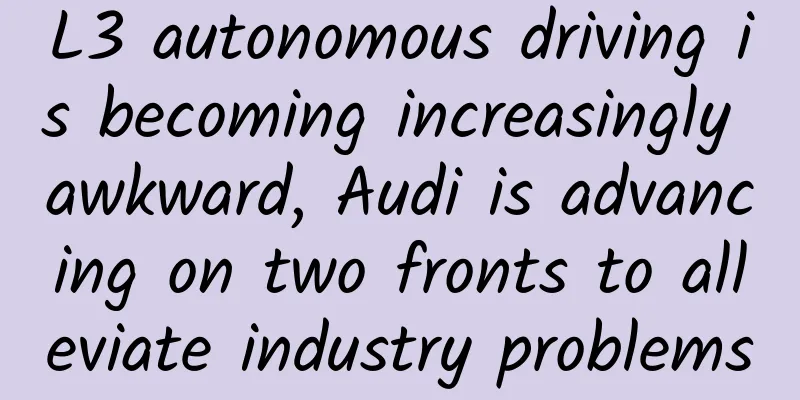L3 autonomous driving is becoming increasingly awkward, Audi is advancing on two fronts to alleviate industry problems

|
There has never been a shortage of big players in the field of autonomous driving. Many car companies have finally made breakthrough progress in L2 level autonomous driving and want to make a quick move to L3 level autonomous driving technology. However, they find that L3 level autonomous driving technology is a hundred times more difficult and has greater moral pressure than L2 level autonomous driving technology. Even Bosch, a leading international Tier 1 supplier, has postponed the mass production of L3 from the original 2019 to 2021, and now to "indefinitely". Although this problem is closely related to inadequate technology, when we carefully analyze L3 autonomous driving technology, we may ask ourselves, is it possible that there is a problem with the technical standards? The dual pressure of morality and technology According to the "China Automobile Driving Automation Classification" released by the Ministry of Industry and Information Technology, the full name of L3 level autonomous driving is "conditional autonomous driving". Most driving operations can be completed by the car, but the driver needs to pay attention at all times to avoid accidents. It seems that there are still actually two drivers for L3 level autonomous driving, one is a computer and the other is a human driver. This also gives rise to a series of problems. First of all, the positioning of L3 is more ambiguous than that of L2. Although L3 is a step up from L2, in terms of specific operation, it still involves two drivers, but under L3 technology, the computer can process more information than L2. In specific use, since L3 can take on most of the driving work, humans who are allowed to leave the steering wheel may not be able to process information in time, causing tragedies, and are not as safe as L2 technology, which requires drivers to focus at all times. Of course, advocates of L3 technology believe that sufficient safety can be achieved as long as humans are given control of the car in an emergency. However, this involves the issue of handing over vehicle control. In the industry, there is no standard on how to hand over, when to hand over, and how long it takes to complete the handover. Every manufacturer has a different understanding. For example, when encountering a situation that it cannot handle at all, Audi cars that reach L3 level will choose to stop the car completely and then hand over control to the user. If it is at high speed, the consequences of such a dangerous approach are self-evident. More importantly, unlike L2 level autonomous driving, where humans are responsible for the main operations, L4 level, where machines are responsible for the main operations, L3 level, where humans and computers are responsible for dual operations, makes the responsibility of car driving swing between computers and humans. Once an accident occurs, the responsible party will be entangled, which restricts legislation and insurance on the one hand, and puts a tight ring on car companies on the other hand, so they dare not easily release L3 level cars. Although the issue we are discussing is only in theory because cars equipped with L3 autonomous driving technology are not yet in large-scale commercial use, some radical car manufacturers have allowed us to see the potential dangers of L3 autonomous driving in reality. Tesla's problems are also the industry's problems In the field of smart cars, Tesla has always been a radical "leftist". Perhaps due to its early entry, Tesla cars have already commercialized the leading L2.5 level autonomous driving technology. In order to make its products more eye-catching, Tesla has also been using marketing to make up for the 0.5 level gap with L3. It is precisely this radical product strategy that has repeatedly put Tesla in the spotlight and made it the target of public criticism. In 2016, a Chinese Tesla Model X owner was killed when he collided with a road sweeper while driving on the highway. Afterwards, the police determined that the Tesla's autopilot function was turned on, but Tesla refused to admit it. Eventually, the owner's family paid for an authoritative appraisal agency to conduct an inspection, which confirmed that the Tesla's autopilot function was turned on. Tesla was forced to admit its mistake and apologize to the victim's family. Interestingly, after the incident, Tesla changed the “autonomous driving” function on its official website to “automatic assisted driving,” probably in the hope of getting rid of its own responsibility if problems arise in the future. Coincidentally, in 2018, an Apple engineer was driving a Model X when it suddenly crashed into a roadblock on both sides of the road, causing the engineer's unfortunate death. Similarly, the car also had the "autopilot" function turned on when the accident occurred, and the owner had both hands off the steering wheel before the accident. When discussing this matter, the chairman of the National Transportation Safety Board of the United States said that the reason for this accident was that the Model X did not achieve timely risk avoidance and warning, and the exaggerated attributes of "automatic assisted driving" also made the driver careless. In the former case, Tesla was too bold in its promotion and “actively” assumed the driving responsibility that should have been borne by consumers, which caused legal issues. In the latter case, in 2018, Tesla had become conservative in promoting the “automatic assisted driving” function and actively educated drivers to assume driving responsibilities, but it was still difficult for drivers to stay focused at all times. This is the case with L2.5 autonomous driving technology. It is easy to imagine the problems that will arise when L3 autonomous driving technology, which has a more vague scope of responsibility and more inaccurate handover boundaries than L2.5, is decentralized. Audi is making great strides in developing L4 Although Tesla's autonomous driving technology has always been the leader in the commercial field, when we look at the entire automotive industry, Tesla's autonomous driving technology is not the most advanced - as early as 2017, Audi debuted the mass-produced Audi A8 equipped with L3 autonomous driving technology. However, Audi did not disregard the safety of drivers like Tesla and insisted on delegating L3 autonomous driving technology. On the contrary, there were even rumors that Audi had canceled the L3 autonomous driving research and development project. Of course, Audi denied the rumor and stated that it had only upgraded the project to the Volkswagen Group level. No matter how Audi denies it, we know that the L3 autonomous driving research and development project will no longer be Audi's focus in the future. This is partly due to the technical defects of L3 autonomous driving, and partly due to Audi's sense of responsibility as a traditional car company. Of course, as a car company with a century-old history, Audi will never abandon its entire autonomous driving strategy just because L3-level autonomous driving technology cannot be easily decentralized. Instead, Audi is strengthening higher-level autonomous driving technology. Specifically, Audi has taken two routes in terms of autonomous driving. One is to focus on L2-level autonomous driving technology with humans as the responsible entity, and the other is to focus on L4-level autonomous driving technology with computers as the responsible entity. In terms of L2 autonomous driving technology, Audi will focus on developing L2.9 functions, that is, to achieve assisted autonomous driving under certain conditions, but human intervention is always required. Considering that Audi is the first automaker in the industry to demonstrate L3 autonomous driving technology, it is expected that it will be able to commercialize L2 with ease. In this way, the responsible parties are regulated and consumers can use autonomous driving technology with better experience, killing two birds with one stone. In terms of L4, Audi also led the world in demonstrating L4 autonomous driving and connected cars for its passenger car fleet on a closed section of Yanchong Expressway at the end of 2019. Audi also said earlier that it will launch its first L4 AI in 2025. From this point of view, Audi may continue the brilliant performance of its debut L3. At this point, when we look back at the L3 level of autonomous driving technology, we will find that this is really an awkward positioning that is not as good as the best but better than the worst. It not only limits manufacturers from launching creative products, but also makes consumers bear a large part of the risks. Although Audi announced the L3-level car early on, after seeing the defects of L3-level autonomous driving technology, it realistically changed direction. On the one hand, it commercializes L2, and on the other hand, it develops L4. In the future, it will inevitably achieve a dimensionality reduction attack on those manufacturers who are still focused on L3-level autonomous driving technology. As a winner of Toutiao's Qingyun Plan and Baijiahao's Bai+ Plan, the 2019 Baidu Digital Author of the Year, the Baijiahao's Most Popular Author in the Technology Field, the 2019 Sogou Technology and Culture Author, and the 2021 Baijiahao Quarterly Influential Creator, he has won many awards, including the 2013 Sohu Best Industry Media Person, the 2015 China New Media Entrepreneurship Competition Beijing Third Place, the 2015 Guangmang Experience Award, the 2015 China New Media Entrepreneurship Competition Finals Third Place, and the 2018 Baidu Dynamic Annual Powerful Celebrity. |
<<: Hongmeng is on the road, and Huawei is on board
>>: Tesla delivered 88,400 vehicles in Q1 2020, of which 76,200 were Model 3 and Model Y
Recommend
Hong Kong Film "Flag Soldiers" Series 4 (1984-1990) Collection with Chinese and Cantonese subtitles
"The Flag" is a film about the life of ...
Technical challenges and practical summary behind the hundreds of billions of visits to WeChat Moments
1. Introduction WeChat Moments consists of two bu...
Do plants need calcium supplements? Calcium deficiency makes plants "difficult to survive" and "unpalatable"
Tuchong Creative What's your first reaction w...
The top ten e-books are free and completed, and the fantasy novels are ranked?
Due to the epidemic, many people are bored at hom...
The fighting power of "autumn mosquitoes" is off the charts. Let's have a "mosquito-killing" storm! See the "vicious" flowers
After finally getting through the summer mosquito...
WeChat bank card payment prompt error: three steps to find out the reason
What should I do if an error message appears when...
How much does it cost to develop a Leshan fresh food mini program? Leshan fresh food mini program development price inquiry
The main factors affecting the price of mini prog...
Seven Tips to Increase App Revenue (Part 1)
Mobile marketing is a fluid ecosystem. If CPs wan...
How did humans learn to count?
Author: The Nutcracker Studio To this day, we sti...
APP promotion: How to operate an APP without financial support?
Because we mainly talk about how to operate and p...
iOS 17 releases dual system updates!
Yesterday morning, Apple pushed out iOS 17 Beta 4...
Are peanut milk and fruit-flavored milk substitutes for cow's milk? Just a few words difference, but big nutritional difference
Milk is rich in nutrients Not only rich in protei...
How to eat during Chinese New Year?
01 Improve immunity Prevent infection and promote...
Douyin promotion methods, the most comprehensive guide to increasing Douyin fans!
For the promotion and operation of Tik Tok, is it...
The 14th China Xinjiang (Changji) Seed Fair 2022 will be held in August!
The 14th China Xinjiang (Changji) Seed Fair will b...









